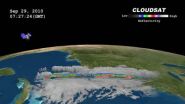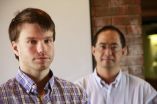(Press-News.org) TORONTO, Sept. 30, 2010 – A waterproof controller designed and built by York University researchers is allowing an underwater robot to go "wireless" in a unique way.
AQUA, an amphibious, otter-like robot, is small and nimble, with flippers rather than propellers, designed for intricate data collection from shipwrecks and reefs.
The robot, a joint project of York, McGill and Dalhousie universities, can now be controlled wirelessly using a waterproof tablet built at York. While underwater, divers can program the tablet to display tags onscreen, similar to barcodes read by smartphones. The robot's on-board camera then scans these two-dimensional tags to receive and carry out commands.
Cutting the cord on underwater robots has been a longstanding challenge for scientists; water interferes with radio signals, hindering traditional wireless communication via modem. Tethered communication is cumbersome and can create safety issues for divers.
"Having a robot tethered to a vehicle above water creates a scenario where communication between the diver, robot, and surface operator becomes quite complicated," says Michael Jenkin, professor in York's Faculty of Science & Engineering and co-author of the forthcoming paper, Swimming with Robots: Human Robot Communication at Depth.
"Investigating a shipwreck, for example, is a very delicate operation and the diver and robot need to be able to react quickly to changes in the environment. An error or a lag in communication could be dangerous," Jenkin says.
Realizing there was no device on the market that fit the bill, Jenkin and his team at York's Centre for Vision Research, including the paper's lead author, MSc student Bart Verzijlenberg, set to work constructing a prototype. The resulting device, fittingly dubbed AQUATablet, is watertight to a depth of 60 feet. Aluminum housing with a clear acrylic cover protects the tablet computer, which can be controlled by a diver using toggle-switches and on-screen prompts.
"A diver at 60 feet can actually teleoperate AQUA 30-40 feet deeper. Needless to say this is much easier on the diver, physically, and much safer," Jenkin says.
The tablet also allows divers to command the robot much as if they were using a video game joystick; turn the tablet right and AQUA turns right, too. In this mode, the robot is connected to the tablet by a slim length of optical cable, circumventing many of the issues of a robot-to-surface tether. The optical cable also allows AQUA to provide video feedback from its camera to the operator. In a totally wireless mode, the robot acknowledges prompts by flashing its on-board light. Its cameras can be used to build 3-D models of the environment which can then be used to guide the robot to particular tasks.
"This is a huge improvement on [a robot] having to travel to the surface to communicate with its operators," Jenkin says.
In past, divers have used laminated flashcards to visually communicate with robots while underwater. However, these limit the diver to a pre-set sequence of commands.
"It's impossible to anticipate everything you're going to want the robot to do once you get underwater. We wanted to develop a system where we could create commands on the fly, in response to the environment," he says.
###
Jenkin and Verzijlenberg's paper will be presented at the IEEE/RSJ International Conference on Intelligent Robots and Systems (IROS) in Taiwan.
A video of the robot is available here: http://www.youtube.com/watch?v=xx0KUqg63F0
Jenkin and Verzijlenberg are two of the researchers based in York's new state-of-the-art Sherman Health Science Research Centre, which officially opened on Sept. 14, 2010. Jenkin leads the Canadian Centre for Field Robotics, which is based on the building's main level. The centre is supported by a grant from the Canada Foundation for Innovation (CFI). The AQUA project is funded in part by the Natural Sciences and Engineering Research Council of Canada (NSERC). York's Centre for Vision Research is part of the Faculty of Health.
York University is the leading interdisciplinary research and teaching university in Canada. York offers a modern, academic experience at the undergraduate and graduate level in Toronto, Canada's most international city. The third largest university in the country, York is host to a dynamic academic community of 50,000 students and 7,000 faculty and staff, as well as 200,000 alumni worldwide. York's 10 Faculties and 28 research centres conduct ambitious, groundbreaking research that is interdisciplinary, cutting across traditional academic boundaries. This distinctive and collaborative approach is preparing students for the future and bringing fresh insights and solutions to real-world challenges. York University is an autonomous, not-for-profit corporation.
END
NANO -- World's smallest antenna . . .
Instead of the conventional long piece of metal or dipole antenna, electronic devices of tomorrow could incorporate an antenna no bigger than a gnat. This is made possible by a design that allows an electrically charged nano-mechanical oscillator to be tuned to specific electromagnetic waves. "Gone will be the days when we need to match the antenna length to the wavelength," said Panos Datskos, a co-developer of this proprietary technology. The potentially revolutionary system detects very small electric fields over large frequency ...
High in an alpine meadow, Gesine Pufal, from the University of Wellington, New Zealand, crouched low to the ground and splashed some water from her water bottle on a low green plant cushion, then sat back waiting to see if something would move. Sound crazy? Many hikers passing by her may have thought so, but Pufal was trying to find potential plant species that possess a type of plant movement called hygrochasy.
Although the ability to move is typically thought to be a characteristic unique to the animal kingdom, plants are also capable of movement, from the sudden ...
Tropical Storm Nicole was a tropical storm for around 6 hours before it weakened into a remnant low pressure area and is now off the Florida coast. NASA Satellite imagery captured different views of Nicole's clouds as the system weakened back into a low pressure area.
While Nicole weakened, a huge trough of low pressure over the U.S. eastern seaboard from Florida to Maine has become the key weathermaker there. The trough, an elongated area of low pressure, is streaming tropical moisture from Nicole's remnants and the Gulf of Mexico, bringing high rainfall totals and severe ...
A new study, derived from novel sleep research conducted by University of California, San Diego researchers 14 years earlier, suggests that the secret to a long life may come with just enough sleep. Less than five hours a night is probably not enough; eight hours is probably too much.
A team of scientists, headed by Daniel F. Kripke, MD, professor emeritus of psychiatry at UC San Diego School of Medicine, revisited original research conducted between 1995 and 1999. In that earlier study, part of the Women's Health Initiative, Kripke and colleagues had monitored 459 women ...
When NASA launched the Interstellar Boundary Explorer (IBEX) on October 19, 2008, space physicists held their collective breath for never-before-seen views of a collision zone far beyond the planets, roughly 10 billion miles away. That's where the solar wind, an outward rush of charged particles and magnetic fields continuously spewed by the Sun, runs into the flow of particles and fields that permeates interstellar space in our neighborhood of the Milky Way galaxy.
No spacecraft had ever imaged the collision zone, which occurs in a region known as the heliosheath, because ...
VIDEO:
See a time-lapse series showing hyper-replication of Salmonella bacteria (red) in epithelial cells from two to seven hours after infection.
Click here for more information.
New findings by National Institutes of Health scientists could explain how Salmonella bacteria, a common cause of food poisoning, efficiently spread in people. In a study published this week in the Proceedings of the National Academy of Sciences, researchers describe finding a reservoir of rapidly ...
A cheetah lies still in the grass. Finally, a gazelle comes into view. The cheetah plunges forward, reaches sixty-five miles per hour in three seconds, and has the hapless gazelle by the jugular in less than a minute. Then it must catch its breath, resting before eating.
A blue whale surfaces, blasting water high from its blowhole. It breathes in great gasps, filling its thousand-gallon lungs with air. Then it descends again to look for krill, staying below for 10, 20, even 30 minutes before taking another breath.
Both animals need oxygen, of course. And both depend ...
Ames, Iowa - An Iowa State University researcher searched for new genes that are turned on during infection in a type of mosquito that is not only a pest, but transmits disease-causing pathogens.
Lyric Bartholomay, assistant professor of entomology, along with colleagues from around the world, infected the common southern house mosquito (Culex quinquefasciatus) with various pathogens to see which mosquito genes are activated in response to the infection.
Bartholomay is the first author on the paper, "Pathogenomics of Culex quinquefasciatus and Meta-Analysis of Infection ...
DARIEN, IL – A study in the Oct. 1 issue of the journal Sleep found that getting too little or too much sleep in early pregnancy is associated with elevated blood pressure in the third trimester. The study suggests that improving prenatal sleep hygiene may provide important health benefits.
Results show that the mean systolic blood pressure in the third trimester was 114 mm Hg in women with a normal self-reported nightly sleep duration of nine hours in early pregnancy, 118.05 mm Hg in women who reported sleeping six hours or less per night, and 118.90 mm Hg in women ...
SAN FRANCISCO, CA– Amblyopia, known as "lazy eye," is a major cause of vision problems in children and a common cause of blindness in people aged 20 to 70 in developed countries. In amblyopia the person's stronger eye is favored and his/her weaker eye gradually loses visual power as a result. When the condition is detected and treated before age 7, more than 75 percent of children achieve 20/30 vision or better, the Amblyopia Treatment Study reports. But parents and teachers can easily miss this problem–especially in very young children. Pediatric ophthalmologists (Eye ...



